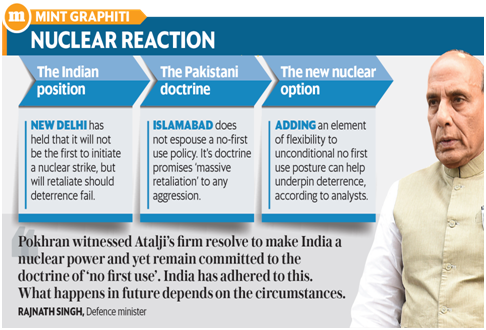



Copyright infringement not intended
Picture Courtesy: INDIAN EXPRESS
Evolving global power dynamics, technological advancements, and threat perceptions require India to reassess its 2003 nuclear doctrine.
|
Read all about: INDIA'S NUCLEAR POLICY l INDIA'S NUCLEAR DOCTRINE FOSTERS STABILITY AMID ARMS RACES l INDIA'S PUSH ON NUCLEAR DETERRENCE l NUCLEAR POWER IN INDIA |
India’s nuclear policy, approved by the Cabinet Committee on Security (CCS) in January 2003 and based on the 1999 draft by the National Security Advisory Board (NSAB).
Credible Minimum Deterrence (CMD): Maintains a survivable, ready, and sufficient nuclear arsenal capable of inflicting unacceptable damage on any aggressor.
No First Use (NFU): Commits to using nuclear weapons only in retaliation against a nuclear attack on its territory or forces.
Massive Retaliation: Any nuclear strike against India would trigger a “massive” retaliatory response aimed at inflicting unacceptable damage.
Non-Use Against Non-Nuclear States: Pledges not to use nuclear weapons against non-nuclear weapon states but retains the right to respond with nuclear force in case of major biological or chemical attacks.
Civilian Political Control: Prime Minister, through the Nuclear Command Authority’s Political Council, holds exclusive authority to order a nuclear strike.
Nuclear Triad: India maintains land, air, and sea-based nuclear capabilities—through Agni missiles, air-delivered weapons, and nuclear submarines like INS Arihant—ensuring credible second-strike capacity.
Commitment to Disarmament: India advocate for a verifiable and non-discriminatory global disarmament framework.

 Why India need Flexibility in Nuclear Doctrine?
Why India need Flexibility in Nuclear Doctrine?
Changing Regional Security Dynamics
China’s Modernization: China’s nuclear arsenal has grown with projections of over 1,000 warheads by 2030.. (Source: U.S. Department of Defense)
Pakistan’s Tactical Nuclear Weapons (TNWs): Pakistan's "full spectrum deterrence" strategy, incorporating low-yield TNWs, challenges India's "massive retaliation" doctrine by necessitating graded response options to avoid disproportionate escalation.
Emerging Domains: Cyber and Space
Cyber Threats: Increasing digital dependence exposes India’s nuclear command, control, and communication (C3) systems to potential cyber attacks.
Space Vulnerabilities: India’s reliance on space assets for communication, navigation, and surveillance adds another layer of risk.
Limited Credibility
NFU Debate: Critics argue that a rigid NFU policy limits India’s ability to deter adversaries who might exploit first-strike advantages.
Massive Retaliation Dilemma: A strict commitment to massive retaliation leaves little room for calibrated or proportional responses, especially in cases of limited nuclear use.
Conditional No First Use (CNFU)
India could adopt a CNFU policy, maintaining its general commitment to not initiating nuclear strikes but extending it to cover non-nuclear attacks that damage national infrastructure.
Flexible Response or Proportional Retaliation
India may opt for a measured nuclear response, matching an adversary's attack in intensity and target, instead of a massive retaliation.
This strategy could boost deterrence, especially against tactical nuclear weapons, but poses challenges in defining proportionality and maintaining control.
Enhanced Strategic Ambiguity
India could adopt strategic ambiguity to deter adversaries by making its retaliatory thresholds unclear, thus complicating their strategic planning.
This approach, however, requires careful management to prevent misunderstandings and accidental escalation.
Strengthening Ballistic Missile Defence (BMD)
An effective BMD system would strengthen India's second-strike capability by safeguarding nuclear weapons from an initial enemy attack; strengthening the credibility of CMD strategy.
Integrating Space and Cyber Deterrence
Doctrine must include space and cyberspace deterrence, with offensive and defensive measures to protect nuclear command-and-control and critical infrastructure.
International Image
India’s NFU stance reinforces its reputation as a responsible nuclear power, helping secure global partnerships and Nuclear Suppliers Group (NSG) support. Diluting NFU could invite diplomatic backlash.
Strategic Stability
NFU reduces incentives for a preemptive strike and prevents an arms race. Abandoning it could destabilize the regional balance.
Escalation Risks
Ambiguity in doctrine might lead to miscalculation during crises.
Economic Costs
Moving toward a first-use posture would require vast financial investment in high-alert systems and advanced ISR (Intelligence, Surveillance, and Reconnaissance) networks.
Ethical Considerations
India’s commitment to restraint aligns with its moral and historical emphasis on peace and non-violence.
India should update its nuclear doctrine to address current threats by adopting a conditional No First Use policy and a flexible response. This requires political consensus, diplomatic skill, and technological advancement, balancing clarity with ambiguity.
Continuous review, international communication, and modernization are essential to maintain credibility and India's reputation as a responsible nuclear power committed to disarmament.
Source: INDIAN EXPRESS
|
PRACTICE QUESTION Q. Evaluate the effectiveness of India's 'No First Use' (NFU) policy in the current geopolitical environment. 150 words |
India's official nuclear doctrine, formally adopted in 2003, is based on a posture of "No First Use" (NFU) and maintaining a "Credible Minimum Deterrent". It asserts that nuclear weapons are for deterrence only and will only be used in massive retaliation against a nuclear attack on Indian territory or forces.
Arguments for flexibility stem from the evolving regional security environment, specifically the nuclear capabilities and doctrines of China and Pakistan. Critics of the current doctrine argue that the "massive retaliation" approach may not be a credible response to a potential low-yield, tactical nuclear weapon (TNW) strike by Pakistan.
Proponents argue that the NFU policy strengthens India's image as a responsible nuclear power, reduces the risk of an accidental nuclear war by avoiding hair-trigger alerts, and prevents a costly nuclear arms race in the region. It also provides diplomatic leverage and supports India's long-standing commitment to global nuclear disarmament.
© 2025 iasgyan. All right reserved